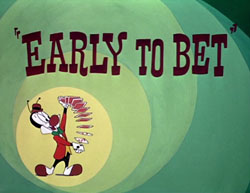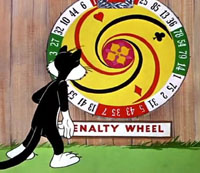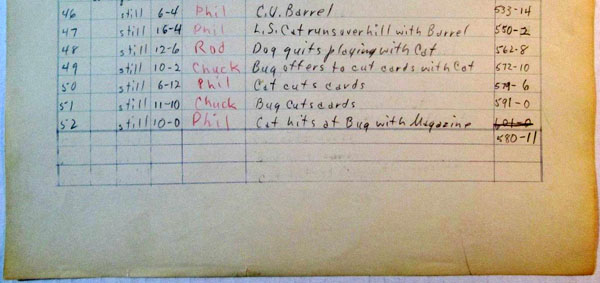“Not the Gesundheit! Not the Gesundheit!” The last breakdown of the month is a cult classic from Bob McKimson…
 On April 2, 1949, Mel Blanc and Stan Freberg recorded their dialogue for Bob McKimson’s Early to Bet. It was the penultimate cartoon that story man Warren Foster wrote for McKimson on a regular basis before he was shifted to Friz Freleng’s unit. Though he settled in as Freleng’s main writer, Foster helmed four more cartoons for McKimson: Of Rice and Hen (1953), Too Hop to Handle (1956), The Unexpected Pest (1956) and A Broken Leghorn (1959); the 1956 releases were written while story man Tedd Pierce spent a brief period at UPA.
On April 2, 1949, Mel Blanc and Stan Freberg recorded their dialogue for Bob McKimson’s Early to Bet. It was the penultimate cartoon that story man Warren Foster wrote for McKimson on a regular basis before he was shifted to Friz Freleng’s unit. Though he settled in as Freleng’s main writer, Foster helmed four more cartoons for McKimson: Of Rice and Hen (1953), Too Hop to Handle (1956), The Unexpected Pest (1956) and A Broken Leghorn (1959); the 1956 releases were written while story man Tedd Pierce spent a brief period at UPA.
As for the animators on the film, John Carey’s work in not credited, though the omission could be from the low amount of footage he is given. Charles McKimson animates the introductory scenes of the Gambling Bug in his native habitat, with appropriate home décor and furniture to match. McKimson handles a nice piece of dimensional animation in scene 2 when the narrator asks the Gambling Bug to stand up so the audience can observe him, and he responds by turning his body in place. Explaining that the (literal) bite from the Gambling Bug causes “gambling fever”, a few recipients are shown for its potency—a man offering “double or nothing” on a dinner bill and another at a slot machine. The bite also contributes to pointless wagers, evident in a scene where two chums at a tavern watch a fly buzz above their beers and wager five dollars on whose it will land on first. The production draft notes an excised sequence with a man playing a pinball machine, intended in place between the restaurant customer and the scene at the tavern.
 Early to Bet was also one of the last cartoons with Cornett Wood’s layouts before he left Warners and was replaced by Pete Alvarado. Scene 12 of the bulldog walking over to a shed, passing the Gambling Bug hiding by a rock (animated by Phil De Lara), is staged in a low angle composition—a brief but astute example of his dynamic work for the studio. After the bulldog finds the cat underneath the shed, he extends an invitation to play a game of “penalties.” Emery Hawkins’ strong poses and movement in scene 15 firmly establish their peculiar relationship built the outcome of the card game that never works in the cat’s favor. Instead of a quiet vacation out in the country for the Gambling Bug, he decides give the cat a bite of “gambling fever.” Originally, there were two brief scenes when the Gambling Bug speaks to the cat before biting him on the ear the first time; one of them was of the cat listening to the bug’s words of influence, fully aware of the inexplicable voice.
Early to Bet was also one of the last cartoons with Cornett Wood’s layouts before he left Warners and was replaced by Pete Alvarado. Scene 12 of the bulldog walking over to a shed, passing the Gambling Bug hiding by a rock (animated by Phil De Lara), is staged in a low angle composition—a brief but astute example of his dynamic work for the studio. After the bulldog finds the cat underneath the shed, he extends an invitation to play a game of “penalties.” Emery Hawkins’ strong poses and movement in scene 15 firmly establish their peculiar relationship built the outcome of the card game that never works in the cat’s favor. Instead of a quiet vacation out in the country for the Gambling Bug, he decides give the cat a bite of “gambling fever.” Originally, there were two brief scenes when the Gambling Bug speaks to the cat before biting him on the ear the first time; one of them was of the cat listening to the bug’s words of influence, fully aware of the inexplicable voice.
 Hawkins also animates the cat’s frenzied reaction to “gambling fever,” as he places the stationary bulldog—still shuffling cards while being shoved—to his seat. His animation continues after the cat loses in a game of gin rummy. As per their routine, the cat is forced to spin a roulette wheel that determines his penalty selected from the designated number in a filing cabinet. The elaborate punishments in the cartoon are a reprise from material in McKimson’s It’s Hummer Time (1950) with the same cat and bulldog designs. In the earlier film, the cat is dragged away by the dog and shouts his pleas (“Not the Thinker!”) without explanation how he’s immediately aware about his impeding penalties. It is probable that the idea of the roulette wheel and the filing cabinet in Early to Bet was a solution from writer Warren Foster to rectify this slight flaw. In scene 27, there appear to be some intended vocal tracks that are absent when the cat is pulled away off-screen to endure the “Gesundheit” penalty; the following scenes are wonderfully animated by Rod Scribner.
Hawkins also animates the cat’s frenzied reaction to “gambling fever,” as he places the stationary bulldog—still shuffling cards while being shoved—to his seat. His animation continues after the cat loses in a game of gin rummy. As per their routine, the cat is forced to spin a roulette wheel that determines his penalty selected from the designated number in a filing cabinet. The elaborate punishments in the cartoon are a reprise from material in McKimson’s It’s Hummer Time (1950) with the same cat and bulldog designs. In the earlier film, the cat is dragged away by the dog and shouts his pleas (“Not the Thinker!”) without explanation how he’s immediately aware about his impeding penalties. It is probable that the idea of the roulette wheel and the filing cabinet in Early to Bet was a solution from writer Warren Foster to rectify this slight flaw. In scene 27, there appear to be some intended vocal tracks that are absent when the cat is pulled away off-screen to endure the “Gesundheit” penalty; the following scenes are wonderfully animated by Rod Scribner.
Scribner animates the second game of gin rummy in scene 37. This time, the cat plays a strategy to withhold a card after he places it on the table. He elicits a cunning, toothy grin when he places it back close to him. However, the cat loses again and has to choose another penalty. As animated by Phil De Lara, his next fate is labeled “William Tell,” after the well-known legend, where he attempts to shoot an apple from the top of his son’s head with a bow and arrow. The third time does not seem to be the charm, as the cat loses another game of gin rummy. De Lara animates the cat’s next penalty, labeled as “Roll Out the Barrel,” which upon reading sends the cat into various panicked poses over to the barrel in question. Worried for the cat’s safety after several punishments, the dog refuses to play anymore and the Gambling Bug takes his place. Their game turns into a one-card draw, and the Gambling Bug pulls out a lower number than the cat. After enduring a streak of bad luck caused by the bug, the cat administers a suitable punishment—“the Post”, swatting the newspaper angrily at him.
 The music cue sheet for Early to Bet was approved a year after early production began, by June 7, 1950. Carl Stalling utilizes different leitmotifs in the musical score throughout much of the film. “We’re in the Money” (Harry Warren/Al Dubin)—from the hit Warner Bros. musical Gold Diggers of 1933—serves as an appropriate theme for many of the scenes with the Gambling Bug. One of Stalling’s favorite cues, John F. Barth’s college march “Frat,” plays whenever the cat is stricken with gambling fever. Perhaps one of the finest usages of Raymond Scott’s second half of “Powerhouse” occurs whenever the bulldog is ready to inflict one of the penalties on the cat. “Blues in the Night” (Harold Arlen/Johnny Mercer), another tune from a Warners musical, is underscored in plaintive tones as the cat receives each penalty.
The music cue sheet for Early to Bet was approved a year after early production began, by June 7, 1950. Carl Stalling utilizes different leitmotifs in the musical score throughout much of the film. “We’re in the Money” (Harry Warren/Al Dubin)—from the hit Warner Bros. musical Gold Diggers of 1933—serves as an appropriate theme for many of the scenes with the Gambling Bug. One of Stalling’s favorite cues, John F. Barth’s college march “Frat,” plays whenever the cat is stricken with gambling fever. Perhaps one of the finest usages of Raymond Scott’s second half of “Powerhouse” occurs whenever the bulldog is ready to inflict one of the penalties on the cat. “Blues in the Night” (Harold Arlen/Johnny Mercer), another tune from a Warners musical, is underscored in plaintive tones as the cat receives each penalty.
The general release of the cartoon occurred on May 12th, 1951. It was reissued under the “Blue Ribbon” banner, which is the most common version, on May 30th, 1959. Enjoy the video (and in the correct pitch, too)! Please excuse the quality of the draft pages, as these were culled from an eBay auction.



An Important Announcement: From hereon out, my columns will not be so frequent. With the task of performing film restoration in addition to writing for Cartoon Research every other month, it has become just a little difficult to manage. This does not mean the column has ended indefinitely—only that I will post on an irregular basis, like many contributors on this site. I might post updated Cartoon Research articles on my Patreon page—for instance, my profile on animator Bob Wickersham will have more extensive information than on the site. Hats off to the historians and experts who have helped me with my posts!
As for film restoration, I’m hoping to expand into more opportunities in the field, while still helping out with Thunderbean Animation. I’ve just now finished the clean-up for Wilbur the Lion, and I am pleased with the results—just needs a slight tweak in contrast and color correction. Be sure to look on my Patreon for restoration progress videos, as well!
One thing’s for sure: I’ve saved my next set of posts for something special. Once I have the research I need, I’ll be ready to share it with you all. I think you’re going to like it…
(Thanks to Keith Scott and Andrew Gilmore for their help.)


 DEVON BAXTER is a film restoration artist, video editor, and animation researcher/writer currently residing in Pennsylvania. He also hosts a
DEVON BAXTER is a film restoration artist, video editor, and animation researcher/writer currently residing in Pennsylvania. He also hosts a 




















































































Wonderful! Well done! This series is a favourite of mine, and it’s too bad that McKimson and Foster didn’t get to collaborate on more of them.
“The Gambling Bug will get you if you don’t watch out” is a reference to the old Pinky Tomlin song “The Love Bug Will Bite You (If You Don’t Watch Out)”. Darla Hood sings it in the “Our Gang Follies of 1938”. Pinky had a contract with MGM, so Stalling wasn’t able to quote the song itself here.
There’s a clip from “It’s Hummer Time” in the 1983 movie “The Twilight Zone” (“No! Please! Not Happy Birthday!”), along with other classic cartoons such as “Bimbo’s Initiation”.
Looking forward to you next special posts. Best of luck to you in the future.
A Flintstones cartoon, the one about Frantic City and a bird named Diposy, ad the “doctor'(a Water Buffalo Lodge member)..quote both The Dipsy Doodle AND The Love Bug will bite you..
Hairspray, produced by Warners through New Line, had Amanda Bynes (herself able to play different roles a la Blanc) as Penny Pingleton being locked in her family basementr by her mom, to keep her out of integrated teen dances shows of the 19690sm saying Not the Jump rope!
That Flintstones episode was also written by Warren Foster!
Thanks Devon! Another opportunity to appreciate Robert McKimson.
Or any McKimson at WB, for that matter.
“Not the Cat!” That poor damn cat. Appeared in several cartoons. Always got blowed up real good.
And never even had a name.
Show biz is a cruel mistress.
Why was there ever an issue with the PITCH of this cartoon?
In addition to the former Tashlin and Clampett animators, Warren Foster was what made McKimson’s cartoons among the best WB cartoons of the late 40s and early 50s. So much great dialogue in those shorts and tis one is no exception. Such a tragedy that McKimson lost him. For an underrated director, McKimson sure knew how to utilize the most expressive talent.
This cartoon’s music track, particularly the rendition of Powerhouse, was reused extensively in “Daffy Duck’s Quackbusters”. It’s unfortunate that the music-only track wasn’t included with the short’s Golden Collection release, because it’s Carl Stalling at his best.
Indeed. Closest we got was the track on the Carl Stalling Project CD which contained excerpts from this cartoon, as well as “Corn Plastered”, “Drip-Along Daffy”, and a few others.
Anyway, this is one of my all-time favorite Robert McKimson cartoons. What a magnificent personification of the gambler’s logical fallacy mindset: “If I just keep playing, I’m bound to win SOMETIME!” Plus I love the unnamed bulldog character, how calm he is at dishing out punishments.
Great voice acting in this short, too. I’ve always loved the cat’s giddy “Ah, ah, ah…” when dealt the cards, as well as his “OHHH no you don’t, I still got my finger on it, wise guy.”
Would this be one of the final uses of “Blues in the Night” by Stalling? Can’t recall hearing it in any of the mid/late ’50s cartoons.
It played in 1953’s “A Peck o’ Trouble”, I think that was the last instance.
It is likely that Carl Stalling was not thinking of “Frat” when he used it in the score of this cartoon. He may have been thinking of the then-most-recent iteration of the melody. This was set to a lyric that became a hit for Kay Kyser called “Horses Don’t Bet On People”. The melody is also known as “Three Cheers for Father” from its use in “Yankee Doodle Daffy” and “A Bear For Punishment”, A similar if not identical melody was appended to a lyric which begins “All is Not Gold That Glitters” from an early Merrie Melodie set in the gay 90’s, and in its use in “Bowery Bugs”.